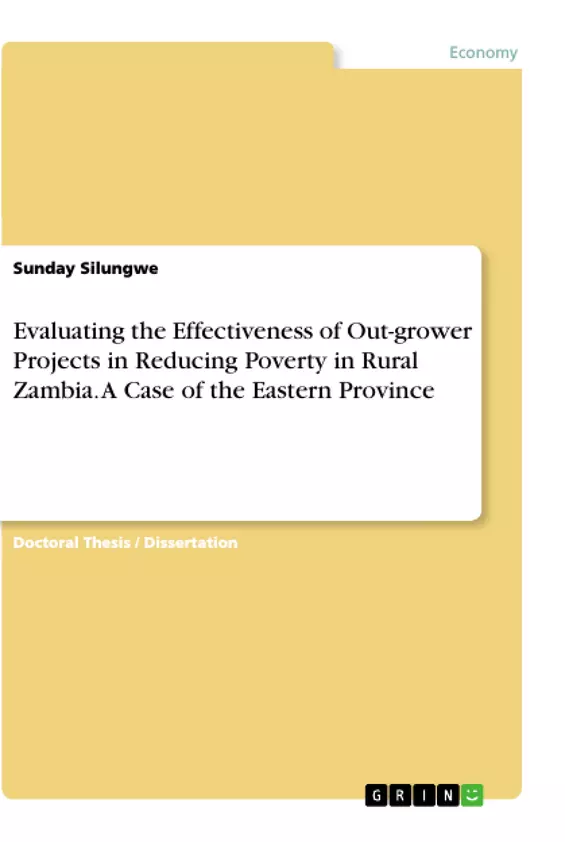The Living Conditions Monitoring Survey (LCMS) conducted in 2015 revealed that rural poverty stood at 76.6 percent and 23.4 percent for urban poverty respectively. To this effect, rural poverty still remains high and predominantly a rural phenomenon. This study sought to evaluate the effectiveness of the out-grower schemes on reducing poverty and answer the general research question on how effective were the out-grower schemes in reducing poverty in rural Zambia.
Pragmatism was the philosophical view that underpinned the study and it applied to the mixed research method approach for this study. The convergent parallel strategy of the mixed research method approach was used. The target population was 50,000 smallholder farmers and a questionnaire with open ended questions (qualitative) and closed questions (quantitative) was administered to a sample size of 396 smallholders farmers. Simple random sampling was used to select smallholder farmers.Qualitative data was analyzed by using the inductive process of building from the data to broad themes and then to interpretation. Quantitative data was analysed by using the Chi-square tests to ascertain association between critical variables measured by categories of out-grower farmers and independent farmers. The T-tests compared the treatment and control groups on variables of interest. The coefficient of variation (CV) was used to gauge the level of respondents’ disagreement (dissention) in responses while coefficient of consensus (CC) was used to gauge the level of respondents’ agreement (consensus) in responses, applied to the Likert scale and any other ordinal responses.
The findings from the study revealed that the out-grower schemes implementation has contributed to a positive change in poverty reduction to smallholder farmers participating in the out-grower scheme. Further, out-grower farmers have improved their knowledge in understanding the operation of the out-grower scheme. Subsequently, the out-grower schemes have benefited the communities. In this regard, the study concluded that the out-grower schemes have been effective in reducing poverty in the rural areas of Zambia. The study recommended that there was need to address the issue of power imbalance between the out-grower farmers and the out-grower firms.
Inhaltsverzeichnis (Table of Contents)
- CHAPTER ONE: INTRODUCTION
- 1.1 Background to the Study
- 1.2 Statement of the Problem
- 1.3 Research Objectives
- 1.4 Research Questions
- 1.5 Significance of the Study
- 1.6 Scope and Delimitation of the Study
- 1.7 Definition of Key Terms
- CHAPTER TWO: LITERATURE REVIEW
- 2.1 Conceptual Framework
- 2.2 Poverty and Out-grower Projects
- 2.3 Out-grower Projects in Zambia
- 2.4 The Role of Out-grower Projects in Rural Development
- 2.5 Empirical Evidence of Out-grower Projects
- CHAPTER THREE: RESEARCH METHODOLOGY
- 3.1 Research Design
- 3.2 Target Population and Sampling Procedure
- 3.3 Data Collection Instruments and Procedures
- 3.4 Data Analysis Techniques
- CHAPTER FOUR: RESULTS AND DISCUSSION
- 4.1 Socio-economic Characteristics of the Respondents
- 4.2 Participation in Out-grower Projects
- 4.3 Impact of Out-grower Projects on Poverty Reduction
- 4.4 Challenges Faced by Out-grower Projects
- 4.5 Lessons Learned from the Study
- CHAPTER FIVE: SUMMARY, CONCLUSIONS AND RECOMMENDATIONS
- 5.1 Summary of the Study
- 5.2 Conclusions
- 5.3 Recommendations
Zielsetzung und Themenschwerpunkte (Objectives and Key Themes)
The study aims to evaluate the effectiveness of out-grower projects in reducing poverty in rural Zambia, focusing on the Eastern Province. The study aims to understand the impact of out-grower projects on household income, food security, and access to basic services. It also seeks to identify challenges faced by out-grower projects and explore the role of government policies in facilitating their success.
- The impact of out-grower projects on poverty reduction in rural Zambia.
- The challenges faced by out-grower projects in the Eastern Province.
- The role of government policies in supporting out-grower projects.
- The contribution of out-grower projects to rural development in Zambia.
Zusammenfassung der Kapitel (Chapter Summaries)
- Chapter One provides an introduction to the study, outlining its background, problem statement, research objectives, significance, scope, and delimitation. It also defines key terms used throughout the research. Chapter Two reviews existing literature on poverty, out-grower projects, and their role in rural development. It also explores empirical evidence from previous studies on the effectiveness of out-grower projects in reducing poverty. Chapter Three describes the research methodology employed in the study, including the research design, target population, sampling procedure, data collection instruments, and data analysis techniques. Chapter Four presents the findings of the study, analyzing the socio-economic characteristics of the respondents, their participation in out-grower projects, the impact of out-grower projects on poverty reduction, challenges faced by out-grower projects, and lessons learned from the study. This chapter focuses on providing a comprehensive overview of the data and its implications for understanding the effectiveness of out-grower projects.
Schlüsselwörter (Keywords)
The study focuses on out-grower projects, poverty reduction, rural development, Zambia, Eastern Province, impact evaluation, household income, food security, access to basic services, government policies, and challenges.
- Quote paper
- Sunday Silungwe (Author), 2020, Evaluating the Effectiveness of Out-grower Projects in Reducing Poverty in Rural Zambia. A Case of the Eastern Province, Munich, GRIN Verlag, https://www.grin.com/document/742051



